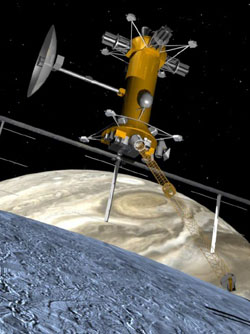
Proposed for launch in 2020, Jupiter Europa Orbiter (JEO) would conduct a choreographed tour of the giant planet and its four largest moons before settling into orbit around Europa.
Arriving in 2025, the mission's primary objective would be to explore Europa from orbit and help improve our understanding of the moon’s suspected global, subsurface ocean. The NASA-led JEO mission is part of a larger proposed effort called the Europa Jupiter System Mission, being planned in partnership with the European Space Agency (ESA). ESA would develop a separate spacecraft to study the Jupiter system in tandem with JEO, with the European probe entering orbit at Ganymede. JEO would be specially designed to cope with Jupiter's dangerous radiation.
Jupiter Europa Orbiter would help to reveal answers to important mysteries of Europa and its neighborhood around Jupiter by investigating the moon’s ice shell and ocean and the potential for life to exist under the surface of icy moons orbiting giant worlds like Jupiter – not just in our own Solar System, but across our galaxy and beyond.
Mission Goal: Explore Europa to Investigate Its Habitability



